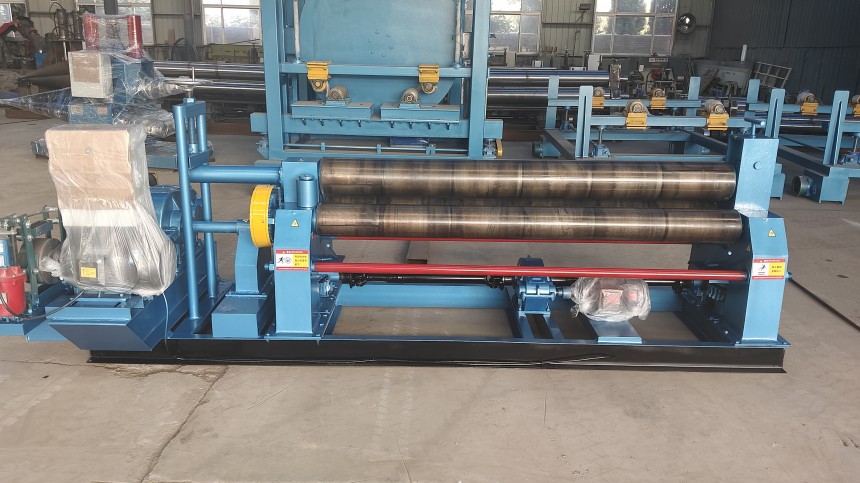

With over a decade of experience in the field of plate rolling machine manufacturing, we have grown into a professional manufacturer. Today, we will introduce the safety signage setup standards for the operational area of plate rolling machines:

As heavy-duty sheet metal processing equipment, the safety signage setup in the operational area of roll forming machines directly impacts the personal safety of operators and the stability of equipment operation. A scientifically sound and reasonable safety signage system can effectively prevent accidents and enhance operators' safety awareness. This article will detail the safety signage setup standards for rolling mill work areas from three aspects: signage classification, setup requirements, and maintenance management.
Safety signs are primarily categorized into four main types. Prohibitory signs feature a white background with a red circle, clearly indicating prohibited actions such as “No Touching” or “No Crossing.” Warning signs use a yellow background with a black border in the shape of a triangle to alert users to potential hazards, such as “Beware of machinery injuries” or “Caution: High voltage.”Instructional signs feature a blue background with white patterns to indicate mandatory operating procedures, such as“Must wear safety goggles”or “Must wear work clothing.” Informational signs use a green background with white patterns to indicate the location of safety facilities, such as“Emergency stop button”or“Safety exit.”
The placement of safety signs is subject to strict requirements. Permanent safety signs must be installed on the equipment itself at hazardous locations. For example,“Caution: Mechanical Entanglement”signs should be placed on moving parts, and “High-Pressure Hazard” signs should be installed on hydraulic systems. At the entrance to the work area, a combination safety sign should be installed, displaying basic information such as the equipment name, hazard level, and protective requirements. Yellow warning lines should be marked on the ground to indicate safe walking areas. Electrical control cabinets must have“No unauthorized personnel allowed”signs posted in a prominent location. For work areas that may generate noise, “Noise Hazard” signs must be placed at the boundaries.
The size and material selection of the signage must comply with standards. The size of the signage on the equipment body should not be less than 100mm×100mm, and the recommended size for area signage is 300mm×400mm. Outdoor work areas should use reflective materials to ensure visibility at night. In high-temperature environments, heat-resistant materials should be used to prevent the signs from deforming or becoming ineffective. The installation height of the signs should be between 1.5 and 1.8 meters to ensure they are within the normal line of sight. When multiple signs are installed simultaneously, they should be arranged according to the level of danger, with the most important sign placed at the top.
The content design of the signage must be standardized and consistent. Text descriptions should use simplified Chinese characters, with English translations provided where necessary. Graphic symbols must adhere to the styles specified in national standards to ensure universality. Hazard levels must be clearly defined, with major hazard sources using more prominent color combinations. Prohibitory signage must specify the specific prohibited actions and cannot be vague. Warning signage should briefly describe the nature of the hazard, such as “Caution: High Temperature Burn Hazard.”
The maintenance and management of signage is equally important. A regular inspection system should be established to check the integrity and clarity of signage on a weekly basis. Any signage that is damaged, faded, or outdated should be replaced promptly. After equipment upgrades or process changes, relevant signage must be updated accordingly. New employee training should include signage identification content to ensure that all operators can correctly understand the meaning of the signage. A signage archive should be established to record information such as installation locations and replacement dates.
Special attention must be paid to special working environments. When working in confined spaces, a“Caution: Ventilation Required”sign must be posted at the entrance. In areas where multiple people are working together, additional signs such as “Caution: Coordinate Work”must be posted. During temporary maintenance work, a“Maintenance in Progress”sign must be hung on the equipment. In automated work areas, a“Caution: Automatic Operation”warning sign must be posted. Hazardous chemical storage areas must have hazard warning signs posted in accordance with regulations.
The effectiveness of safety signage systems must not be overlooked. Regular surveys should be conducted to assess the level of awareness among operators. On-site observations should be carried out to check whether the signage is actually serving its intended warning purpose. Suggestions for improvement should be collected from operators and used to continuously optimize signage placement. After a safety incident occurs, the rationality of the relevant signage should be reevaluated.
With technological advancements, safety signage has also evolved. Smart signage has begun to be applied, such as audio-visual alarm signs and electronic display screens. However, the application of these new technologies cannot replace the foundational role of traditional signage. Regardless of the form used, it is essential to ensure that the signage content is clear, the location is appropriate, and maintenance is timely. Only by establishing a scientific and comprehensive safety signage system can reliable safety assurance be provided for roll forming machine operations.
If you are interested in plate rolling machines, please contact us.
 Address:Room 1202, Detaitang Building, No. 118 Huaguang Road, Zhangdian District, Zibo, Shandong
Address:Room 1202, Detaitang Building, No. 118 Huaguang Road, Zhangdian District, Zibo, Shandong WhatsApp:+8615653328535
WhatsApp:+8615653328535 Wechat: +8615965331535
Wechat: +8615965331535  E-mail:zs@sdsmachinery.com
E-mail:zs@sdsmachinery.com